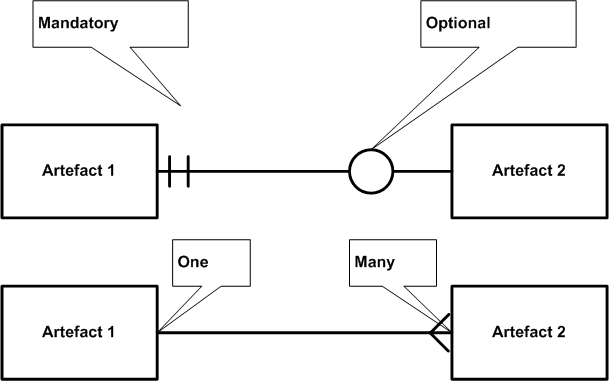

Traceability is based on the following relationships between the artefacts
-
OTO - One To One;
-
OTM - One To Many;
-
MTO - Many To One; or
-
MTM - Many To Many.
These releationship may be:
-
M - Mandatory; or
-
O - Optional.
Traceability
Traceability is the ability to verify the history, location, or application of an item by means of documented recorded identification. Other common definitions include the capability (and implementation) of keeping track of a given set or type of information to a given degree, or the ability to chronologically interrelate uniquely identifiable entities in a way that is verifiable. Depending on the project's nature, preparing the documentation for a project may yield a large number of artefacts, from a few tens to over a million artefacts. These include (but are not limited to:
-
Scope Of Work or Statement of Work (SOW);
-
Project Plans;
-
Project initiation Request (PIR);
-
Business Requirements Document (BRD);
-
Change Requests (CR);
-
Functional Specifications (FS);
-
Supplementary Specifications (SS);
-
The above artefacts my be decomposed into:
-
Business Use Cases (BUC) decomposed into;
-
Group use Cases (GUC) decomposed into;
-
System Use Cases (UCS) decomposed into:
-
Business Scenarios (BSc) decomposed into;
-
Test Cases (TC) grouped into Test Suites (TSu) organised in Software Test Plans (STP) organised into a Master Test Plan (MTP);
-
-
Technical Specifications (TS) derived from the previous item;
-
Test Execution Logs (TEL) summarised by Test Summary Reports (TSR);
-
System documentation (i.e. User Guides, Operational Giuides);
-
Training Documentation; and
-
More.
That is without including versions and revisions.
One must be able to identify (and retrieve) artefacts during the project and after it has been deployed.

Traceability provides access to substantiating evidence to the questions:
-
Why was something done?
-
Has something been done?
-
Where is the artefact?
-
What is the latest version / revision?
-
Was this covered?


